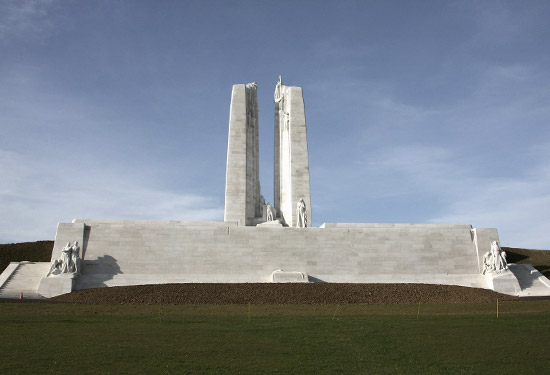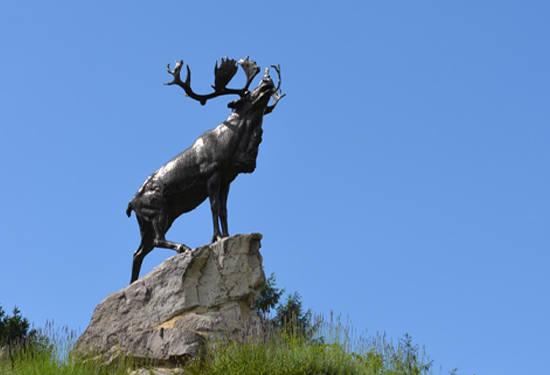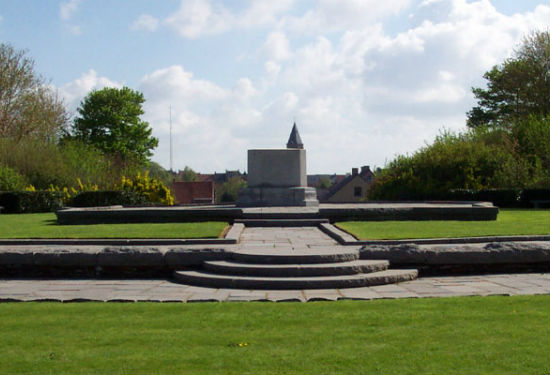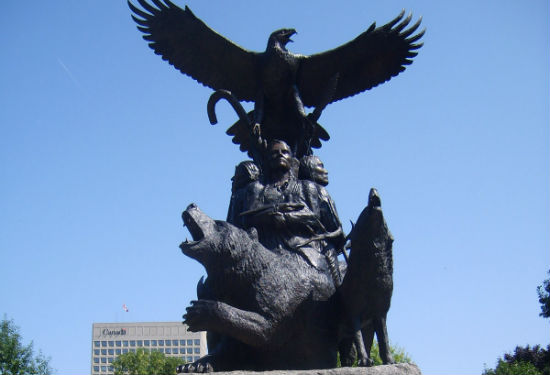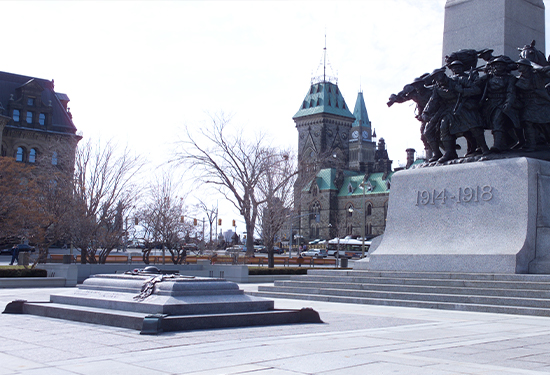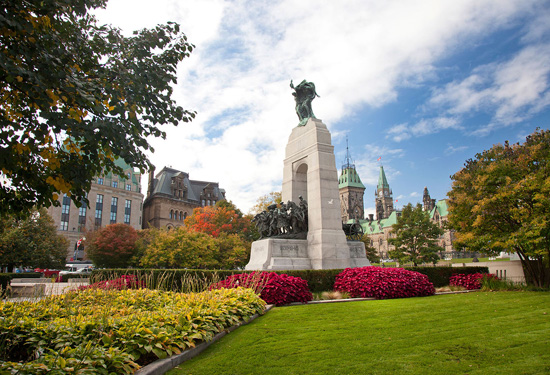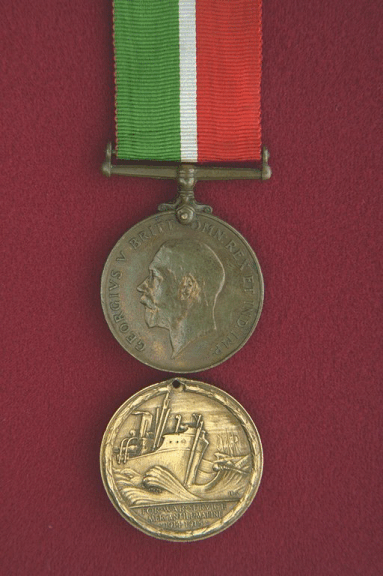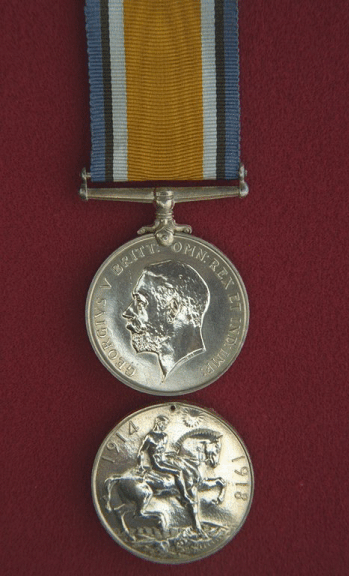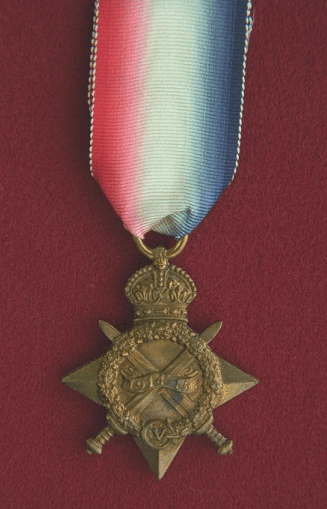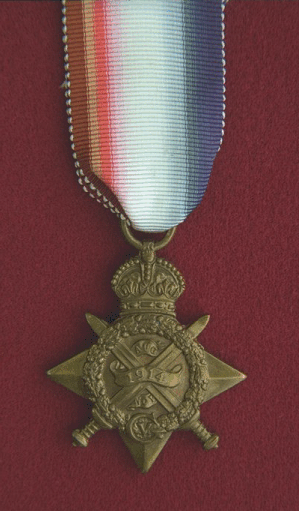
Battle of Beaumont-Hamel
Soldiers from Newfoundland suffered massive losses on one of the bloodiest days of the entire war.
1 July 1916
First World War
Table of contents
Section 1
Classroom materials
Introduction
Most Canadians know July 1st as Canada Day. However, in Newfoundland and Labrador, the day has an additional and more solemn meaning. There, it is also known as Memorial Day and marks the anniversary of the fighting at Beaumont-Hamel during the First World War.

Newfoundland soldiers during the First World War. Courtesy of The Rooms Provincial Archives Division (B 5-147), St. John's, NL.
Newfoundland goes to war
During the time of the First World War (1914-18), Newfoundland was a dominion of the British Empire and not yet a part of Canada. Once Britain declared war on Germany in August 1914, Newfoundland—like Canada— was automatically at war. The people of Newfoundland responded with a great outpouring of patriotism and many rushed to enlist. From a total population of about 240,000, more than 12,000 Newfoundlanders would join up during the war.
The Blue Puttees
The Newfoundland Regiment was quickly assembled and hastily trained, with the first recruits sent overseas in October 1914 to become a unit of the British Army. They would become known as the "Blue Puttees" because of the colour of the uniform leggings they wore on their lower legs.
After seeing action in the Gallipoli campaign in Turkey from September 1915 to January 1916, the regiment was withdrawn and the Newfoundlanders sent to the Western Front in France in the spring of 1916.
The Western Front in 1916
Following the opening battles of 1914, the First World War in Western Europe quickly bogged down into trench warfare with the opposing armies dug in, facing one another from a complex series of trenches across a blasted ‘No Man's Land,' defended by lookouts, barbed wire and guns. Artillery, snipers, grenades, mines, machine guns and sickness took a great toll.

The explosion of a mine under the Hawthorn Redout, the minutes before zero, before the assault at Beaumont-Hamel. Photo: Imperial War Museum, Q 754
The generals could see only one way to end the stalemate—brutal frontal assaults in the face of intense fire to break the enemy defences. The Allied plan for 1916 was to make the "Big Push," and the Somme was chosen as the site for a joint French and British assault. It would be on the first day of the Battle of the Somme—near the village of Beaumont-Hamel in northern France—that the Newfoundland Regiment would enter the action.
Battle of Beaumont-Hamel
At 7:30 a.m., on July 1, thousands of British and French troops began their advance across No Man's Land in broad daylight toward the German positions to open the Battle of the Somme. The result would be slaughter—more than 57,000 British and Commonwealth soldiers were killed, wounded or missing—the heaviest combat losses ever suffered by the British Army in a single day.
The sector of the front at Beaumont-Hamel where the Newfoundland Regiment would see action was supposed to be taken by surprise, but the Germans knew the attack was coming. In addition, the initial Allied bombardment failed to damage most of the German defences.
Newfoundlanders advance
At about 9:15 a.m., the Newfoundlanders—forming part of the 29th British Division—attacked from a support trench nicknamed St. John's Road. They advanced from this trench, which was actually behind the front line, because of the sheer number of soldiers involved in earlier attacks who were dead or wounded and clogging the front trenches. This meant that the Newfoundlanders had to traverse more than 200 metres before they even made it to the Allies' own front line. Once they made it to No Man's Land, they were then expected to cross through tangles of barbed wire to reach the enemy trenches more than 500 metres away.

A wounded man is brought in at the Battle of the Somme, 1916. Courtesy of the Provincial Archives of Newfoundland and Labrador (PANL NA-6067), St. John’s, Newfoundland
As the Newfoundlanders advanced toward the enemy, there was a tree partway down the slope that marked the spot where German fire seemed to become particularly intense. This gnarled tree was nicknamed the "danger tree" by the Newfoundland troops and it marked the spot where many of them would fall that morning. As they walked into the hail of machine gun and artillery fire, it was said that many of them tucked their chins in, almost like they were walking into the teeth of a blizzard back home. But this time it was not snow flying all around them—the Newfoundland Regiment would be practically decimated in less than half an hour of intense German fire.
The human cost of the Somme
July 1st would only be the first day of more than four brutal months of fighting during the Battle of the Somme, a campaign in which Canada would also see significant action. By the time it was all over, the Allies would have more than 650,000 soldiers killed, wounded, missing or taken prisoner, and both the Allies and the Germans would each lose about 200,000 lives. For this incredible cost, the Allies moved the front line forward about 10 kilometres.

Captured German trench at Beaumont-Hamel. Photo: Public archives of Newfoundland and Labrador, B2-44; (2759)
Sacrifice
The losses sustained by the Newfoundland Regiment at Beaumont-Hamel on July 1, 1916, were staggering. Of the some 800 Newfoundlanders who went into battle that morning, only 68 were able to answer the roll call the next day, with more than 700 killed, wounded or missing. The dead included 14 sets of brothers, including four lieutenants from the Ayre family of St. John's.

Barbed wire and mud at Beaumont-Hamel, 1916. Courtesy of the Provincial Archives of Newfoundland and Labrador (PANL NA-2732), St. John’s, Newfoundland
The Newfoundlanders' sacrifice did not go unnoticed on the front lines. The commander of the 29th British Division said of the actions of the Newfoundland Regiment on that July morning:
"It was a magnificent display of trained and disciplined valour, and its assault only failed of success because dead men can advance no further."
After Beaumont-Hamel
The Newfoundland Regiment would be practically wiped out, but the survivors would continue to see action in the fighting and reinforcements would come to help rebuild the regiment. The regiment would go on to earn the official designation "Royal" from the British Crown in recognition of its gallant actions in battles at Ypres and Cambrai later in the war—the only unit of the British Army to earn that distinction during the war years. By the end of the war, more than 6,200 Newfoundlanders had served in its ranks, with more than 1,300 of them losing their lives and another 2,500 being wounded or taken prisoner. The loss of so many young lives, compounded by the number of wounded, disabled and sick who returned to Newfoundland after the war, would have a significant impact on the colony for many years afterward.
Legacy
The incredible sacrifices of the men of the Newfoundland Regiment at Beaumont-Hamel still echo in Newfoundland and Labrador. The citizens of the province pause July 1 to remember those who gave so much to help protect the peace and freedom people in our country enjoy today.

The majestic bronze caribou that overlooks the Beaumont-Hamel Newfoundland Memorial in France. Photo: Veterans Affairs Canada
As one of the most striking First World War memorials in Europe, the Beaumont-Hamel Newfoundland Memorial in France stands as a monument to those from the dominion who gave their lives in the First World War. The site is one of a few where visitors can see a Great War battlefield much as it was, its artillery craters and trenches left untouched after the war. The twisted skeleton of the danger tree has been preserved and still stands at the spot where many brave Newfoundlanders fell on that tragic morning—a permanent reminder of the great courage and sacrifice seen that day. The monument of the great bronze caribou, emblem of the Royal Newfoundland Regiment, stands on the highest point overlooking the former battlefield. At the base of the statue, three bronze tablets bear the names of more than 800 Newfoundlanders who died in the war and have no known grave.

- Date modified:









